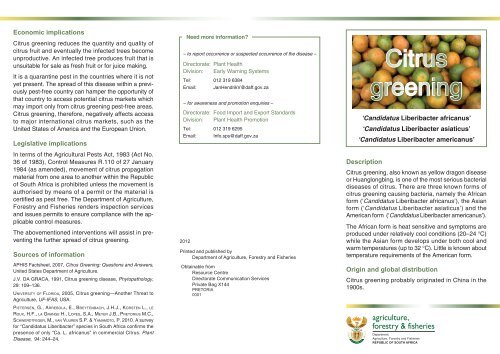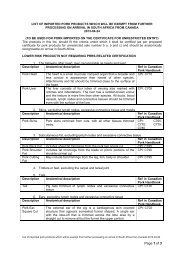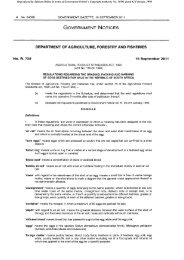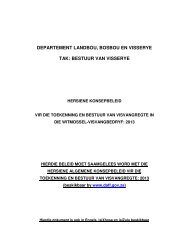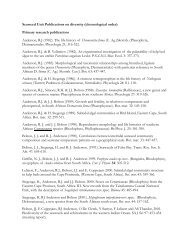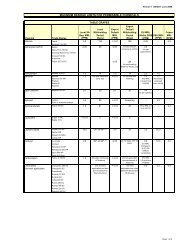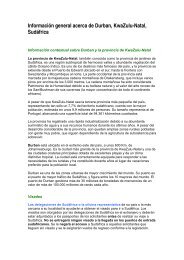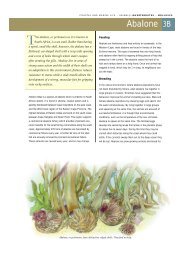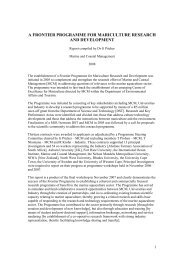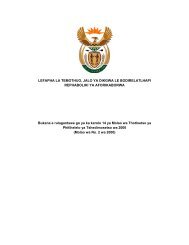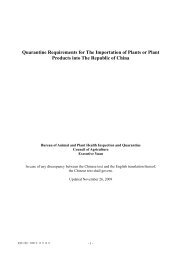Citrus greening - Department of Agriculture, Forestry and Fisheries
Citrus greening - Department of Agriculture, Forestry and Fisheries
Citrus greening - Department of Agriculture, Forestry and Fisheries
Create successful ePaper yourself
Turn your PDF publications into a flip-book with our unique Google optimized e-Paper software.
Economic implications<br />
<strong>Citrus</strong> <strong>greening</strong> reduces the quantity <strong>and</strong> quality <strong>of</strong><br />
citrus fruit <strong>and</strong> eventually the infected trees become<br />
unproductive. An infected tree produces fruit that is<br />
unsuitable for sale as fresh fruit or for juice making.<br />
It is a quarantine pest in the countries where it is not<br />
yet present. The spread <strong>of</strong> this disease within a previously<br />
pest-free country can hamper the opportunity <strong>of</strong><br />
that country to access potential citrus markets which<br />
may import only from citrus <strong>greening</strong> pest-free areas.<br />
<strong>Citrus</strong> <strong>greening</strong>, therefore, negatively affects access<br />
to major international citrus markets, such as the<br />
United States <strong>of</strong> America <strong>and</strong> the European Union.<br />
Legislative implications<br />
In terms <strong>of</strong> the Agricultural Pests Act, 1983 (Act No.<br />
36 <strong>of</strong> 1983), Control Measures R.110 <strong>of</strong> 27 January<br />
1984 (as amended), movement <strong>of</strong> citrus propagation<br />
material from one area to another within the Republic<br />
<strong>of</strong> South Africa is prohibited unless the movement is<br />
authorised by means <strong>of</strong> a permit or the material is<br />
certified as pest free. The <strong>Department</strong> <strong>of</strong> <strong>Agriculture</strong>,<br />
<strong>Forestry</strong> <strong>and</strong> <strong>Fisheries</strong> renders inspection services<br />
<strong>and</strong> issues permits to ensure compliance with the applicable<br />
control measures.<br />
The abovementioned interventions will assist in preventing<br />
the further spread <strong>of</strong> citrus <strong>greening</strong>.<br />
Sources <strong>of</strong> information<br />
APHIS Factsheet, 2007, <strong>Citrus</strong> Greening: Questions <strong>and</strong> Answers,<br />
United States <strong>Department</strong> <strong>of</strong> <strong>Agriculture</strong>.<br />
J.V. DA GRACA, 1991, <strong>Citrus</strong> <strong>greening</strong> disease, Phytopathology,<br />
29: 109–136.<br />
UNIVERSITY OF FLORIDA, 2005, <strong>Citrus</strong> <strong>greening</strong>—Another Threat to<br />
<strong>Agriculture</strong>, UF-IFAS, USA.<br />
PIETERSEN, G., ARREBOLA, E., BREYTENBACH, J.H.J., KORSTEN L., LE<br />
ROUX, H.F., LA GRANGE H., LOPES, S.A., MEYER J.B., PRETORIUS M.C.,<br />
SCHWERDTFEGER, M., VAN VUUREN S.P. & YAMAMOTO, P. 2010. A survey<br />
for “C<strong>and</strong>idatus Liberibacter” species in South Africa confirms the<br />
presence <strong>of</strong> only “Ca. L. africanus” in commercial <strong>Citrus</strong>. Plant<br />
Disease, 94: 244–24.<br />
2012<br />
Need more information?<br />
– to report occurrence or suspected occurrence <strong>of</strong> the disease –<br />
Directorate: Plant Health<br />
Division: Early Warning Systems<br />
Tel: 012 319 6384<br />
Email: JanHendrikV@daff.gov.za<br />
– for awareness <strong>and</strong> promotion enquiries –<br />
Directorate: Food Import <strong>and</strong> Export St<strong>and</strong>ards<br />
Division: Plant Health Promotion<br />
Tel: 012 319 6295<br />
Email: Info.sps@daff.gov.za<br />
Printed <strong>and</strong> published by<br />
<strong>Department</strong> <strong>of</strong> <strong>Agriculture</strong>, <strong>Forestry</strong> <strong>and</strong> <strong>Fisheries</strong><br />
Obtainable from<br />
Resource Centre<br />
Directorate Communication Services<br />
Private Bag X144<br />
PRETORIA<br />
0001<br />
Description<br />
<strong>Citrus</strong><br />
<strong>greening</strong><br />
‘C<strong>and</strong>idatus Liberibacter africanus’<br />
‘C<strong>and</strong>idatus Liberibacter asiaticus’<br />
‘C<strong>and</strong>idatus Liberibacter americanus’<br />
<strong>Citrus</strong> <strong>greening</strong>, also known as yellow dragon disease<br />
or Huanglongbing, is one <strong>of</strong> the most serious bacterial<br />
diseases <strong>of</strong> citrus. There are three known forms <strong>of</strong><br />
citrus <strong>greening</strong> causing bacteria, namely the Afri can<br />
form (‘C<strong>and</strong>idatus Liberibacter africanus’), the Asian<br />
form (‘C<strong>and</strong>ida tus Liberi bacter asiaticus’) <strong>and</strong> the<br />
Ame rican form (‘C<strong>and</strong>idatus Liberibacter americanus’).<br />
The African form is heat sensitive <strong>and</strong> symptoms are<br />
produced under relatively cool conditions (20–24 °C)<br />
while the Asian form develops under both cool <strong>and</strong><br />
warm temperatures (up to 32 °C). Little is known about<br />
temperature requirements <strong>of</strong> the American form.<br />
Origin <strong>and</strong> global distribution<br />
<strong>Citrus</strong> <strong>greening</strong> probably originated in China in the<br />
1900s.<br />
agriculture,<br />
forestry & fisheries<br />
<strong>Department</strong>:<br />
<strong>Agriculture</strong>, <strong>Forestry</strong> <strong>and</strong> <strong>Fisheries</strong><br />
REPUBLIC OF SOUTH AFRICA
The Asian form (‘C<strong>and</strong>idatus Liberi bac ter asiaticus’) is<br />
the most severe <strong>and</strong> geo graphically widespread. It<br />
occurs throughout Asia, the Indian subcontinent <strong>and</strong><br />
neighbouring isl<strong>and</strong>s, the Saudi Ara bian peninsula,<br />
Brazil, southern Florida, California, Cuba, Mauritius,<br />
Reunion <strong>and</strong> Ethiopia.<br />
The African form (‘C<strong>and</strong>idatus Liberi bac ter africanus’)<br />
is less severe <strong>and</strong> is more restricted geographically. It<br />
is found in Africa, south <strong>of</strong> the Sahara.<br />
The American form (‘C<strong>and</strong>idatus Liberi bacter america<br />
nus’) is so far known to occur in Brazil, Cuba, Flor i-<br />
da, Belize, Mexico <strong>and</strong> Dominican Republic.<br />
Symptoms<br />
<strong>Citrus</strong> plants affected by citrus <strong>greening</strong> bacteria may<br />
not show symptoms for years following infection.<br />
Initial symptoms on a tree include the appearance <strong>of</strong><br />
yellow shoots. As the bacteria move within a tree, the<br />
entire canopy progressively develops a yellow colour.<br />
The three forms <strong>of</strong> bacteria produce similar symptoms.<br />
The most characteristic foliar symptoms <strong>of</strong> citrus<br />
<strong>greening</strong> are blotchy mottling <strong>of</strong> the leaves <strong>and</strong> yellowing<br />
<strong>of</strong> leaf veins <strong>and</strong> shoots. Young leaves may display<br />
symptoms that can be misdiagnosed as signs <strong>of</strong> zinc<br />
deficiency. Older leaves take on the mottling charac-<br />
teristic <strong>of</strong> <strong>greening</strong>. Other symptoms include twig dieback,<br />
poor flowering <strong>and</strong> stunted growth.<br />
Fruit from diseased trees is small, <strong>of</strong>ten abnormal <strong>and</strong><br />
typically some green colour remains even on ripe fruit.<br />
Greening-affected fruit taste bitter, medicinal <strong>and</strong><br />
sour. Seeds usually abort, <strong>and</strong> fruit formation is poor.<br />
Symp toms vary according to the time <strong>of</strong> infection,<br />
stage <strong>of</strong> disease, tree species <strong>and</strong> tree maturity.<br />
Transmission<br />
This disease is primarily spread by two species <strong>of</strong><br />
psyllid insect, namely the Asian citrus psyllid (Dia pho r-<br />
ina citri) <strong>and</strong> the African citrus psyllid (Trioza erytreae).<br />
Both species transmit the citrus <strong>greening</strong> pathogen<br />
from infected trees to healthy trees as they feed on<br />
the plants. <strong>Citrus</strong> <strong>greening</strong> can also be transmitted by<br />
grafting infected budwood, by dodder, <strong>and</strong>, possibly,<br />
by infected seed.<br />
Host range<br />
<strong>Citrus</strong> <strong>greening</strong> in South Africa is largely a disease <strong>of</strong><br />
sweet orange (<strong>Citrus</strong> sinensis), with valencias showing<br />
more distinct leaf symptoms than navels. It is also<br />
particularly severe on m<strong>and</strong>arins (C. reti culata) <strong>and</strong><br />
tangelos (C. sinensis x C. reticulata), but less on<br />
lemon (C. limon), grapefruit (C. paradisi) <strong>and</strong> sour<br />
orange (C. aurantium).<br />
However, cultivars such as lime (C. aurantifolia), pomelo<br />
(C. gr<strong>and</strong>is), <strong>and</strong> trifoliate orange (Ponicirus trifoliate)<br />
are tolerant to the disease. In general, most citrus<br />
species <strong>and</strong> their relatives are susceptible.<br />
Identification methods<br />
The only definitive method <strong>of</strong> diagnosis on trees suspected<br />
to be infected by the citrus <strong>greening</strong> pathogen<br />
(Huanglongbing) is polymerase chain reaction (PCR)<br />
in an author ised plant diagnostic laboratory. In South<br />
Africa, this can be done by the <strong>Department</strong> <strong>of</strong> Agri culture,<br />
<strong>Forestry</strong> <strong>and</strong> <strong>Fisheries</strong>’ diagnostic laboratories in<br />
Stellenbosch.<br />
Control methods<br />
Control <strong>of</strong> citrus <strong>greening</strong> can be achieved through an<br />
integrated approach which includes eradicating infected<br />
plant material, introducing clean nursery seedlings,<br />
adhering to regulatory measures <strong>and</strong> eliminating<br />
insect vectors by means <strong>of</strong> systemic insecticides (as<br />
they are sap feeders).<br />
Treating affected trees with injections <strong>of</strong> antibiotics<br />
alleviates the symptoms, but does not cure the diseased<br />
plants. Prompt elimination <strong>of</strong> diseased trees is<br />
strongly advised.<br />
Typical blotchy mottling<br />
symptoms <strong>of</strong> citrus<br />
<strong>greening</strong> on citrus spp<br />
Feeding damage to citrus<br />
leaves caused only by the<br />
African citrus psyllid,<br />
Trioza erytreae<br />
Infected orange<br />
Nymph <strong>of</strong><br />
the Asian<br />
citrus psyllid<br />
Adult Asian citrus<br />
psyllid<br />
Adult <strong>of</strong> the African citrus<br />
psyllid<br />
Nymph <strong>of</strong> African citrus psylid


